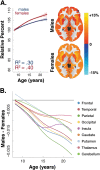Sex differences in the developing brain: insights from multimodal neuroimaging
- PMID: 29930385
- PMCID: PMC6235840
- DOI: 10.1038/s41386-018-0111-z
Sex differences in the developing brain: insights from multimodal neuroimaging
Abstract
Youth (including both childhood and adolescence) is a period when the brain undergoes dramatic remodeling and is also a time when neuropsychiatric conditions often emerge. Many of these illnesses have substantial sex differences in prevalence, suggesting that sex differences in brain development may underlie differential risk for psychiatric symptoms between males and females. Substantial evidence documents sex differences in brain structure and function in adults, and accumulating data suggests that these sex differences may be present or emerge during development. Here we review the evidence for sex differences in brain structure, white matter organization, and perfusion during development. We then use these normative differences as a framework to understand sex differences in brain development associated with psychopathology. In particular, we focus on sex differences in the brain as they relate to anxiety, depression, psychosis, and attention-deficit/hyperactivity symptoms. Finally, we highlight existing limitations, gaps in knowledge, and fertile avenues for future research.
Conflict of interest statement
The authors declare no competing interests.
Figures





Similar articles
-
Multimodal Structural Neuroimaging Markers of Brain Development and ADHD Symptoms.Am J Psychiatry. 2019 Jan 1;176(1):57-66. doi: 10.1176/appi.ajp.2018.18010034. Epub 2018 Sep 17. Am J Psychiatry. 2019. PMID: 30220220
-
Sex is a defining feature of neuroimaging phenotypes in major brain disorders.Hum Brain Mapp. 2022 Jan;43(1):500-542. doi: 10.1002/hbm.25438. Epub 2021 May 5. Hum Brain Mapp. 2022. PMID: 33949018 Free PMC article. Review.
-
Tracking Brain Development and Dimensional Psychiatric Symptoms in Children: A Longitudinal Population-Based Neuroimaging Study.Am J Psychiatry. 2018 Jan 1;175(1):54-62. doi: 10.1176/appi.ajp.2017.16070813. Epub 2017 Aug 18. Am J Psychiatry. 2018. PMID: 28817944
-
Right care, first time: a highly personalised and measurement-based care model to manage youth mental health.Med J Aust. 2019 Nov;211 Suppl 9:S3-S46. doi: 10.5694/mja2.50383. Med J Aust. 2019. PMID: 31679171
-
Developmental neurogenetics and multimodal neuroimaging of sex differences in autism.Brain Imaging Behav. 2017 Feb;11(1):38-61. doi: 10.1007/s11682-015-9504-3. Brain Imaging Behav. 2017. PMID: 26781567 Free PMC article. Review.
Cited by
-
Psychobiological risk factors for suicidal thoughts and behaviors in adolescence: a consideration of the role of puberty.Mol Psychiatry. 2022 Jan;27(1):606-623. doi: 10.1038/s41380-021-01171-5. Epub 2021 Jun 11. Mol Psychiatry. 2022. PMID: 34117365 Free PMC article. Review.
-
Gender Dysphoria: A Review Investigating the Relationship Between Genetic Influences and Brain Development.Adolesc Health Med Ther. 2020 Aug 5;11:89-99. doi: 10.2147/AHMT.S259168. eCollection 2020. Adolesc Health Med Ther. 2020. PMID: 32801984 Free PMC article. Review.
-
Altered cortical structure and psychiatric symptom risk in adolescents exposed to maternal stress in utero: A retrospective investigation.Behav Brain Res. 2019 Dec 16;375:112145. doi: 10.1016/j.bbr.2019.112145. Epub 2019 Aug 7. Behav Brain Res. 2019. PMID: 31400378 Free PMC article.
-
Neuroscience and Sex/Gender: Looking Back and Forward.J Neurosci. 2020 Jan 2;40(1):37-43. doi: 10.1523/JNEUROSCI.0750-19.2019. Epub 2019 Sep 5. J Neurosci. 2020. PMID: 31488609 Free PMC article. Review.
-
Genetic and environmental influence on resting state networks in young male and female adults: a cartographer mapping study.Hum Brain Mapp. 2023 Nov;44(16):5238-5293. doi: 10.1002/hbm.25947. Epub 2022 Dec 20. Hum Brain Mapp. 2023. PMID: 36537283 Free PMC article.
References
-
- Sisk CL, Zehr JL. Pubertal hormones organize the adolescent brain and behavior. Front Neuroendocrinol. 2005;26:163–74. - PubMed
-
- Polanczyk G, Lima MSDe, Horta BL, Biederman J, Rohde LA. The worldwide prevalence of ADHD: a systematic review and metaregression analysis. Am J Psychiatry. 2007;164:942–8. - PubMed
Publication types
MeSH terms
Grants and funding
LinkOut - more resources
Full Text Sources
Other Literature Sources

